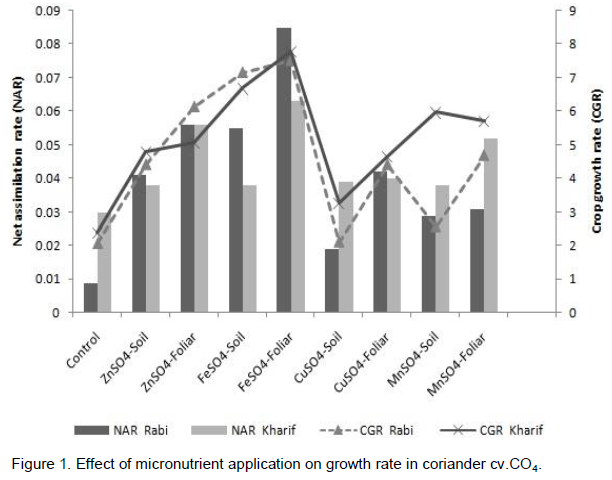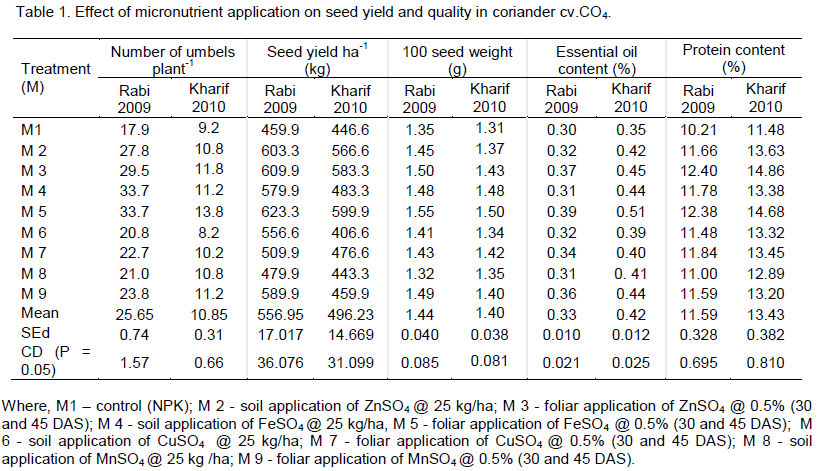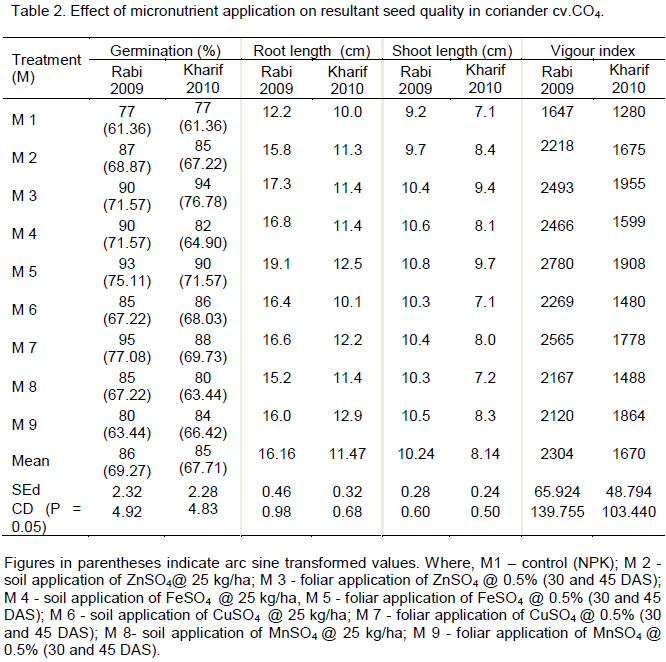ABSTRACT
The field experiments were conducted during two seasons to find out the role of micronutrients on growth, seed yield and quality in coriander cv. CO4. The soil of the experimental site was calcareous. Micronutrient deficiencies are common in soils that have a high calcium carbonate (CaCO3) due to reduced solubility at alkaline pH values. Micronutrients such as iron (Fe), zinc (Zn), copper (Cu) and manganese (Mn) were applied in their sulphate form (FeSO4, ZnSO4, CuSO4 and MnSO4, respectively). The effect of both soil application (25 kg/ha) and foliar spray (0.5%) of micronutrients at 30 and 45 days after sowing were studied individually. Foliar spray of 0.5% FeSO4 induced the highest growth rates in terms of net assimilation rate (0.085 mg g-1day-1in rabi and 0.063 mg g-1day-1 in kharif) and crop growth rate (7.52 mg m-2 day-1in rabi and 7.78 mg m-2 day-1in kharif). Maximum number of umbels per plant (33.7 in rabi and 13.8 in kharif) and highest seed yield per hectare (623.3 kg in rabi and 599.9 kg in kharif) were observed for the foliar application of 0.5% FeSO4 if compared to other treatments. Foliar application of iron and zinc exhibited significant effect on resultant seed quality parameters. The study revealed the need for application of micronutrients in maximum realization of yield and quality of the coriander seed crop in calcareous soils.
Key words: Coriander, foliar spray, growth, iron, micronutrients, quality, seed yield, zinc.
The seed spices constitute an important group of agricultural commodities. Among the seed spices, coriander is the most important spice crop with multipurpose utility. Coriander (
Coriandrum sativum L.) is an annual herb of the
apiaceae family. For adequate plant growth and production, micronutrients are needed in small quantities; however, their deficiencies cause a great disturbance in the physiological and metabolic processes in the plant. Micronutrients application plays an important role in the production of good quality and high yield of crops (Amjad et al., 2014). The role of micronutrients in photosynthesis, N-fixation, respiration and other metabolic processes of the plant is well documented (Naga Sivaiah et al., 2013). The effects of micronutrient foliar fertilizer on the promotion of growth and production of some medicinal and aromatic plants were observed by several researchers (Nasiri et al., 2010; Joynul et al., 2012; Mazaheri et al., 2013). Application of micronutrients significantly influenced the number of branches, umbels per plant, seeds per umbel and seed yield of coriander (Kalidasu et al., 2008). Improved fertilizer management is required to grow crops successfully on calcareous soils. Iron, Zinc, Manganese and Copper deficiencies are common in soils that have a high calcium carbonate (CaCO
3) due to reduced solubility at alkaline pH values. The present study was undertaken to assess the potential of micronutrients in the improvement of seed yield and quality of coriander cv.CO
4.
Pure seeds of coriander (C. sativum L.) cv. CO4 which formed the base material for the study were obtained from the Department of Spices and Plantations Crops, TNAU, Coimbatore. The field experiment was conducted at the orchard of HC & RI, Coimbatore in two seasons (Rabi, 2009; Kharif, 2010). Before sowing, physical and chemical properties of the soil of the experimental site were determined (Jackson, 1973). The soil of the experimental site was clayey textured and calcareous with a pH of 8.10. The results of soil chemical analysis were as follows: electrical conductivity (ds/m) = 0.14; available nitrogen (kg/ha) = 207; available phosphorus (kg/ha) = 15.4; available potassium (kg/ha) = 849; copper (ppm) = 2.22, manganese (ppm) = 7.50; iron (ppm) = 4.16 and zinc (ppm) = 1.06. Seeds were sown in plot size of 3 × 1.5 m with a spacing of 15 × 10 cm following randomized block design with 9 treatments involving four micronutrients viz. iron (Fe), zinc (Zn), copper (Cu) and manganese (Mn) applied through soil (25 kg/ha) and foliar spray (0.5%) individually at 30 and 45 days after sowing (DAS) and three replications. The details of treatments are as follows:
M 1 - Control (NPK)
M 2 - Soil application of ZnSO4 @ 25 kg/ha
M 3 - Foliar application of ZnSO4 @ 0.5%
M 4 - Soil application of FeSO4 @ 25 kg/ha
M 5 - Foliar application of FeSO4 @ 0.5%
M 6 - Soil application of CuSO4 @ 25 kg/ha
M 7 - Foliar application of CuSO4 @ 0.5%
M 8- Soil application of MnSO4 @ 25 kg/ha
M 9 - Foliar application of MnSO4 @ 0.5%
All other cultural practices were followed according to standard recommendations for the locality. Five randomly selected plants in each treatment and in each replication were selected for recording the observations. Observations on growth, seed yield and resultant seed quality characteristics were taken.
The biometric characters like net assimilation rate (NAR) and crop growth rate (CGR) were calculated for different plant growth stages (30, 40, 50 and 60 days after sowing). The sample means were then taken as representative of the population. Five plants were randomly selected in each treatment for recording dry matter production. Plants were oven dried at 70°C till uniform constant weight was obtained. Completely dried samples were weighed and the dry weight of different plant parts was expressed in g per plant. NAR was calculated using the following formula (Williams, 1946) and expressed as mg g-1day-1.
Where t1, t2 - days of observation; L2, L1- leaf dry weight at t2 and t1; w2, w1 - whole plant dry weight at t2 and t1.
Crop growth rate (CGR) was calculated using the following formula (Watson, 1952) and expressed as mg m-2 day-1.
Where, t1, t2 - days of observation; w2, w1 - whole plant dry weight at t2 and t1; P - spacing in m2.
Seed quality parameters such as germination (ISTA, 2003), vigour index (Abdul–Baki and Anderson, 1973), protein content (Ali-Khan and Youngs, 1973) and essential oil content (ASTA, 1968) were also determined in the harvested seeds. The data was analysed for ‘F’ test of significance following the statistical methods described by Panse and Sukhatme (1985).
Micronutrients played a vital role in the growth and development of coriander cv. CO4. Among the two methods (soil application and foliar spray) of application of micro nutrients, foliar spraying was more effective. The positive influence of foliar application of micronutrients on crop growth may be due to the improved ability of the crop to absorb nutrients, photosynthesis and better sink source relationship as these play vital role in various biochemical processes. These findings are in conformity with the studies of Nasiri et al. (2010).
Foliar spray of 0.5% FeSO4 recorded highest net assimilation rate (0.085 mg g-1day-1in rabi and 0.063 mg g-1day-1 in kharif) and was followed by foliar spray of 0.5% ZnSO4 (0.056 mg g-1day-1in rabi and kharif) (Figure 1). Higher concentrations of iron in the leaves and leaf tips resulted in increased photosynthesis and more chlorophyll formation (Nadim et al., 2012). Crop growth rate refers to the dry matter production in a unit of time. Difference in crop growth rate due to micronutrient application was significant in both seasons. Foliar application of 0.5% FeSO4 recorded highest crop growth rate (7.52 mg m-2 day-1in rabi and 7.78 mg m-2 day-1in kharif) (Figure 1). Control recorded lowest crop growth rate in both seasons (2.05 in rabi and 2.37 mg m-2 day-1 in kharif). Iron acts as an important catalyst in the enzymatic reactions of the metabolism and would have helped in larger biosynthesis of photo assimilates thereby enhancing growth of the plants. Besides the function of iron in the metabolism of chloroplast RNA, it is required at several steps in the biosynthetic pathways leading to increase in the biosynthesis materials (produced and accumulated) consequently, the growth was enhanced. Zinc is a component of carbonic anhydrase, as well as several dehydrogenases and auxin production which in turn enhance plant growth. The present study was in accordance with the findings of Said-Al Ahl and Mahmoud (2010), Salmasi et al., (2012) and Abbas (2013). It was also noticed that foliar application of copper initially caused leaves burning which subsequently reduced the CGR.

Among the yield parameters maximum number of umbels (33.7 in rabi and 13.8 in kharif) and the highest seed yield ha-1 (623.3 kg in rabi and 599.9 kg in kharif) were observed for foliar application of 0.5% FeSO4 compared to other treatments(35% increase over control) (Table 1). The yield improvement may be attributed to higher yield attributing components such as increased plant growth, maximum number of umbels and seeds, which were positively affected by the foliar application of iron. Iron improves photosynthesis and assimilates transportation to sinks and finally increased seed yield (Ebrahimian and Ahmad, 2011). Zeidan et al. (2010) reported that application of Fe, Mn and Zn significantly increased grain yield and yield components of wheat.

Among the seed quality characters, 100 seed weight was higher for the seeds obtained from the plants sprayed with iron (1.55 g in rabi and 1.50 g in kharif ) (Table 1). The increase in seed weight might be due to better mineral utilization of plants accompanied with enhancement of photosynthesis, other metabolic activity and greater diversion of food material to seeds (Naga Sivaiah et al., 2013). Foliar spray of zinc and iron recorded higher protein content (12.40 and 12.38%, respectively in rabi and 14.86 and 14.68%, respectively in kharif) (Table 1). Germination was equally enhanced by foliar spray of zinc, iron and copper (90, 93 and 95%, respectively during rabi) and maximum germination was for the seeds of plants sprayed with zinc (94%) during kharif. Foliar spray of FeSO4 recorded highest root and shoot length and vigour index (2780 in rabi and 1908 in kharif) (Table 2). The increase in seed quality parameters may be due to the participation of micronutrients (Zn, Fe, Cu and Mn) in catalytic activity and breakdown of complex substances into simple forms like glucose, amino acids and fatty acids. These in turn were reflected on enhanced germination, elongation of root and shoot of coriander seedling (Santosh, 2012).

Foliar spray of 0.5% FeSO4 recorded higher essential oil content (0.39% in rabi and 0.51% in kharif) followed by ZnSO4 (Table 1). This effect of micronutrients on more essential oil percentage may be attributed to their effect on enzymes activity and metabolism improvement. The essential oil yield increased with iron and zinc applications because there was a significant increase in dry matter yield. The results on the effects of micronutrients on coriander plants agreed with the results obtained by Khalid (1996) and Mehrab (2014) who reported that trace elements such as Fe, Zn and Mn increased the vegetative growth characters and essential oil content of different plants such as anise, coriander, sweet fennel and lemon balm.
Coriander responded well to micronutrients. Foliar spray of micronutrients was advantageous over soil application because of rapid response, effectiveness and elimination of deficiency symptoms. From the above results, it can be concluded that the foliar application of 0.5% FeSO4 significantly enhanced the growth, seed yield and quality of coriander in the calcareous soils of Coimbatore.
The authors have not declared any conflict of interest.
Sincere thanks to scientific team, TNAU, Coimbatore for having provided the technical support and laboratory facilities for the study.
REFERENCES
|
Abbas MK (2013). Effect of foliar fertilizer and some growth regulators on vegetative and anatomical characters of dill (Anethum graveolens L.). Middle-East J. Sci. Res. 13:803-811. |
|
|
Abdul-Baki AA, Anderson JD (1973). Vigour determination of soybean seeds by multiple criteria. Crop Sci. 13:630-633.
Crossref |
|
|
|
|
Ali-Khan ST, Youngs CG (1973). Variation in protein content of field peas. Can. J. Plant Sci. 53:37-41.
Crossref |
|
|
Amjad A, Sajida P, Syed N, Muhammad S, Zengqiang Z, Fazli W, Mohib S, Shahida B, Abdul M (2014). Effect of foliar application of micronutrients on fruit quality of peach. Am. J. Plant Sci. 5:1258-1264.
Crossref |
|
|
|
ASTA (1968). Official Analytical Methods. 2nd Edn. American Spice Trade Association 38:9-10. |
|
|
|
Ebrahimian E, Ahmad B (2011). Effect of iron foliar fertilization on growth, seed and oil yield of sunflower grown under different irrigation regimes. Middle-East J. Sci. Res. 9:621-627. |
|
|
|
ISTA (2003). International Rules for Seed Testing. Zurich, Switzerland: ISTA. |
|
|
|
Jackson ML (1973). Soil chemical analysis. Prentice Hall Indian Private Limited. New Delhi pp. 200-250. |
|
|
|
Joynul AM, Nurul AM, Jamal HM, Nure AA, Kazi M, Faisal H (2012). Effect of micronutrients on growth and yield of onion under calcareous soil environment . Int. J. Biosci. 2:95-101. |
|
|
|
Kalidasu G, Sarada C, Yellamanda RT (2008). Influence of micronutrients on growth and yield of coriander (Coriandrum sativum) in rainfed vertisols. J. Spices Arom. Crops 17:187-189. |
|
|
|
Khalid A (1996). Effect of fertilization on the growth, yield and chemical composition of some medicinal umbelleferous plant. M. Sc. Thesis, Fac. Agric, Al-Azhar Univ. Cairo. Egypt. |
|
|
|
Mazaheri M, Fakheri B, Piri I, Tavassoli A (2013). The effect of drought stress and micronutrient of Zn and Mn on yield and essential oil of (Cuminum cyminum). J. Novel Appl. Sci. 2:350-356. |
|
|
|
Mehrab Y (2014). Effects of micronutrients foliar application on essential oils of Lemon balm (Melissa officinalis L.). Advan. Environ. Biol. 8:1063-1068. |
|
|
|
Nadim MA, Awan IU, Baloch MS, Khan EA, Naveed K, Khan M A (2012). Response of wheat (Triticum aestivum l.) to different micronutrients and their application methods. J. Anim. Plant Sci. 22:113-119. |
|
|
|
Naga SK, Swain SK, Sandeep VV, Raju B (2013). Effect of foliar application of micronutrients on growth parameters in tomato (Lycopersicon esculentum mill.). J. Agric. Food Sci.1:146-151. |
|
|
|
Nasiri Y, Saeid Z-S, Safar N, Nosratollah N, Kazem G-G (2010). Effects of foliar application of micronutrients (Fe and Zn) on flower yield and essential oil of chamomile (Matricaria chamomilla L.). J. Med. Plants Res. 4(17):1733-1737. |
|
|
|
Panse VG, Sukhatme PV (1985). Statistical methods for Agricultural workers. ICAR, Publication, New Delhi pp. 327-340. |
|
|
|
Said-Al Ahl HAH, Mahmoud Abeer A (2010). Effect of zinc and / or iron foliar application on growth and essential oil of sweet basil (Ocimum basilicum L.) under salt stress. Ozean J. Appl. Sci. 3:97-111. |
|
|
|
Salmasi SZ, Behrouznajhad S, Golezani KG (2012). Effects of foliar application of Fe and Zn on seed yield and mucilage content of psyllium at different stages of maturity. International Conference on Environment, Agriculture and Food Sciences, Phuket (Thailand). |
|
|
|
Santosh K (2012). Effect of micronutrients on quality of fruit and seed in tomato (Solanum lycopersicum L.) Internat. J. Farm. Sci. 2:43-46. |
|
|
|
Watson DJ (1952). The physiological basis of variation in yield. Advances in Agron. Academic Press Inc. New York 4:101-144. |
|
|
|
Williams RF (1946). The physiology of plant growth with special reference to the concept of net assimilation rate. Ann. Bot. 10:41-72. |
|
|
|
Zeidan MS, Mohamed MF, Hamouda HA (2010). Effect of foliar fertilization of Fe, Mn and Zn on wheat yield and quality in low sandy soils fertility. World J. Agric. Sci. 6:696-699. |